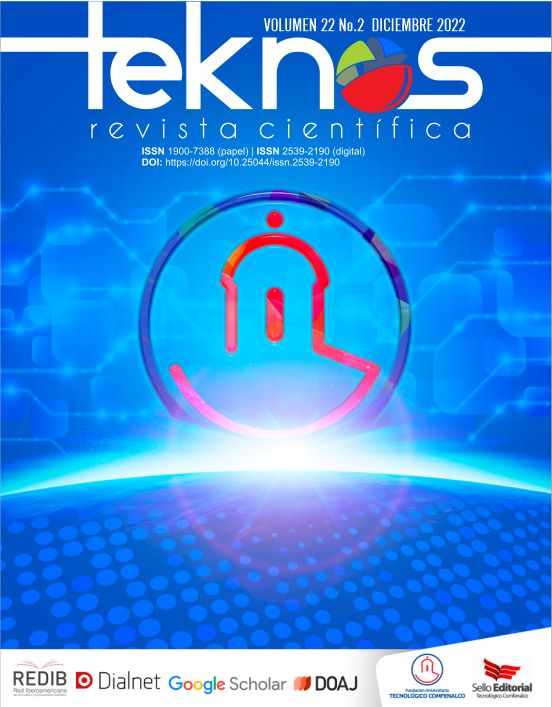Study of the optimal geographic distribution for air quality monitoring sensors air quality
DOI:
https://doi.org/10.25044/25392190.1049Keywords:
sensors , air quality , validity environment , meteorological characteristicsAbstract
This bibliographic review presents a study and analysis of the works developed on the form, methodology and techniques used for the distribution of air quality sensors in a given space, taking into account the different geographical and meteorological characteristics of the selected site. In addition, it is important to highlight that the analysis is carried out through the selection of different research works that have sensors that serve as stations or as low-cost sensors, for which there are different purposes of use in data collection. Finally, a summary is made through tables that mention the main recommendations of the authors, who dealt with this topic in their research and some of the important factors that had to be taken into account given the space, number of available sensors and validity environment of the measurements made in the studies.
Downloads
References
Parry, M., Arnell, N., Hulme, M., Nicholls, R., & Livermore, M. (1998). Adapting to the inevitable. Nature, 395(6704), 741. https://doi.org/10.1038/27316
Intergovernmental Panel on Climate Change & Intergovernmental Panel on Climate Change. (2015). Drivers, Trends and Mitigation. Clim. Chang. 2014 Mitig. Clim. Chang., 351-412. https://doi.org/10.1017/cbo9781107415416.011
Global Environment Outlook – GEO-6: Summary for Policymakers. (2019). Glob. Environ. Outlook – GEO-6 Summ. Policymakers. https://doi.org/10.1017/9781108639217
Riojas-Rodríguez, H., Da Silva, A. S., Texcalac-Sangrador, J. L., & Moreno-Banda, G. L. (2016). Air pollution management and control in Latin America and the Caribbean: Implications for climate change. Rev. Panam. Salud Publica/Pan Am. J. Public Health, 40(3), 150-159.
undp_co_PUBL_julio_ODS_en_Colombia_los_retos_para_2030_ONU.
index @ luftdaten.info. (n.d.). https://luftdaten.info/
index @ www.metropol.gov.co. (n.d.). https://www.metropol.gov.co/
Gaviria, C., Benavides, Pa., & Tangarife, C. (2011). Contaminación por material particulado (pm 2, 5 y pm 10) y consultas por enfermedades. Rev. Fac. Nac. Salud Pública, 29, 241-250. https://www.redalyc.org/pdf/120/12021452003.pdf
Partículas, M. D. E., Pm, P. M. Y., La, P., La, V. D. E., & Aire, D. E. L. (2018). INTEGRACIÓN Y TEST DE MÓDULOS DE.
Morawska, L., Jayaratne, E. R., Bae, J., Bahreini, R., Birmili, W., Cao, J. J.,… Zhang, Q. (2018). Applications of low-cost sensing technologies for air quality monitoring and exposure assessment: How far have they gone? Environment International, 116, 286-299. https://doi.org/10.1016/j.envint.2018.04.018
Lancia, G., Rinaldi, F., & Serafini, P. (2018). A facility location model for air pollution detection. Math. Probl. Eng., 2018. https://doi.org/10.1155/2018/1683249
Liu, D. H. F. (2000). Air pollution. United States of America: Taylor & Francis.
Hsieh, H. P., De Lin, S., & Zheng, Y. (2015). “Inferring air quality for station location recommendation based on urban big data. Proceedings of the ACM SIGKDD International Conference on Knowledge Discovery and Data Mining, 437-446. Doi: 10.1145/2783258.2783344.
Fontanini, A. D., Vaidya, U., & Subramanian, B. G. (2016). “A methodology for optimal placement of sensors in enclosed environments: A dynamical systems approach”. Building and Environment, 100, 145-161. Doi: 10.1016/j.buildenv.2016.02.003.
Cordero, J. M., Borge, R., & Narros, A. (2018). “Using statistical methods to carry out in field calibrations of low-cost air quality sensors”. Sensors and Actuators B: Chemical, 267, 245-254. Doi: 10.1016/j.snb.2018.04.021.
Rackes, A., Ben-David, T., & Waring, M. S. (2018). “Sensor networks for routine indoor air quality monitoring in buildings: Impacts of placement, accuracy, and number of sensors”. Science and Technology for the Built Environment, 24(2), 188-197. Doi: 10.1080/23744731.2017.1406274.
Pantazaras, A., Santamouris, M., Lee, S. E., & Assimakopoulos, M. N. (2018). “A decision tool to balance indoor air quality and energy consumption: A case study”. Energy and Buildings, 165, 246-258. Doi: 10.1016/j.enbuild.2018.01.045.
Feinberg, S. N., et al. (2019). “Examining spatiotemporal variability of urban particulate matter and application of high-time resolution data from a network of low-cost air pollution sensors”. Atmospheric Environment, 213, 579-584. Doi: 10.1016/j.atmosenv.2019.06.026.
Ma, J., Ding, Y., Cheng, J. C. P., Jiang, F., & Wan, Z. (2019). “A temporal-spatial interpolation and extrapolation method based on geographic Long Short-Term Memory neural network for PM2.5”. Journal of Cleaner Production, 237, 117729. Doi: 10.1016/j.jclepro.2019.117729.
Munir, S., Mayfield, M., Coca, D., & Jubb, S. A. (2019). “Structuring an integrated air quality monitoring network in large urban areas – Discussing the purpose, criteria and deployment strategy”. Atmospheric Environment X, 2. Doi: 10.1016/j.aeaoa.2019.100027.
Lim, C. C., et al. (2019). “Mapping urban air quality using mobile sampling with low-cost sensors and machine learning in Seoul, South Korea”. Environmental International, 131, 105022. Doi: 10.1016/j.envint.2019.105022.
Lee, S. Y., Lee, I. B., Yeo, U. H., Kim, R. W., & Kim, J. G. (2019). “Optimal sensor placement for monitoring and controlling greenhouse internal environments”. Biosystems Engineering, 188, 190-206. Doi: 10.1016/j.biosystemseng.2019.10.005.
Sun, C., Yu, Y., Li, V. O. K., & Lam, J. C. K. (2019). “Multi-type sensor placements in Gaussian spatial fields for environmental monitoring”. Sensors (Switzerland), 19(1), 1889. Doi: 10.3390/s19010189.
Admasie, A., Kumie, A., Worku, A., & Tsehayu, W. (2019). “Household fine particulate matter (PM2.5) concentrations from cooking fuels: the case in an urban setting, Wolaita Sodo, Ethiopia”. Air Quality, Atmosphere & Health, 12(6), 755-763. Doi: 10.1007/s11869-019-00700-0.
Al-Harbi, M., & BuHamra, S. (2019). “The level of particulate matter (PM2.5) in several indoor public venues”. Environmental Progress & Sustainable Energy, 38(4). Doi: 10.1002/ep.13096.
Nugroho, F. W., Suryono, S., & Suseno, J. E. (2020). “Fog Computing for Monitoring of Various Area Mapping Pollution Carbon Monoxide (CO) with Ordinary Kriging Method”.
Weissert, L. F., Chen, Y., Morawska, L., & Johnson, B. R. (2019). “Low-cost sensors and microscale land use regression: Data fusion to resolve air quality variations with high spatial and temporal resolution”. Atmos. Environ., 213, 285-295. https://doi.org/10.1016/j.atmosenv.2019.06.019
Sun, C., Li, V. O. K., Lam, J. C. K., & Leslie, I. (2019). Optimal Citizen-Centric Sensor Placement for Air Quality Monitoring: A Case Study of City of Cambridge, the United Kingdom. IEEE Access, 7, 47390-47400. https://doi.org/10.1109/ACCESS.2019.2909111
Stampfer, O., Austin, E., Ganuelas, T., Fiander, T., Seto, E., & Karr, C. J. (2020). “Use of low-cost PM monitors and a multi-wavelength aethalometer to characterize PM2.5 in the Yakama Nation reservation”. Atmos. Environ., 224, 117292. https://doi.org/10.1016/j.atmosenv.2020.117292
Lin, Y. C., Chi, W. J., & Lin, Y. Q. (2020). “The improvement of spatial-temporal resolution of PM2.5 estimation based on micro-air quality sensors by using data fusion technique”. Environ. Int., 134, 105305. https://doi.org/10.1016/j.envint.2019.105305
Tagle, M., Cortés, P., Lissi, E., & Aguayo, J. (2020). “Field performance of a low-cost sensor in the monitoring of particulate matter in Santiago, Chile”. Environ. Monit. Assess., 192(3), 210. https://doi.org/10.1007/s10661-020-8118-4
Downloads
Published
How to Cite
Issue
Section








